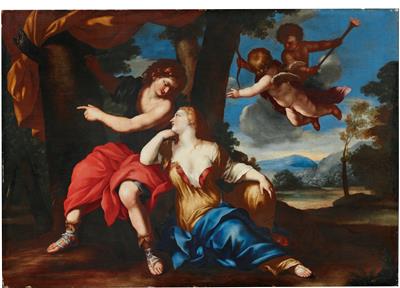Giovanni Francesco Romanelli

(Viterbo 1610–1662)
Angelica and Medoro,
oil on canvas, 121 x 172.5 cm, framed
Provenance:
Villa Stella Maris, Camogli;
sale, Finarte, Milan, 18 October 1995, lot 381 (as Giovanni Francesco Romanelli il Viterbese)
where acquired by the present owner;
Private European collection
The present painting represents an episode from Orlando Furioso, the romance epic by Ludovico Ariosto (canto XIX, verse 17-42) published in 1516. Gravely injured in battle, Medoro is aided by Angelica with whom the protagonist of the chivalric poem, Orlando, is in love. Initially Angelica tends to Medoro’s wounds with a spirit of pity, however in time this turns to romance. The two young people live an idyllic period of love and later the two lovers are married and Angelica decides to return to the Orient with Medoro, at which point, unexpectedly, the anger of Orlando is unleashed. Romanelli’s painting, which is characterised by its refinement of composition and its rich palette, immortalises that moment in the story when the lovers carve their names on the trunk of a tree, watched over by Cupid and an attendant putto, suspended against the blue sky, bearing the symbols of love: the bow and a torch to inflame the heart with love.
Following a brief period of training at Rome with Domenichino, Giovanni Francesco Romanelli was indroduced into the studio of Pietro da Cortona with whom he collaborated on the fresco decoration of the Palazzo Barberini alle Quattro Fontane. This experience marked the beginning of the artist’s long association with the family of Urban VIII. With his first public commissions for the Vatican Basilica, as well as for works in the Vatican Palace, Romanelli began to significantly develop his own baroque language. Finding inspiration in works ranging from those of Raphael to those of Francesco Albani and Guido Reni, he formulated a simplified, functional almost neo-renaissance manner, with which he asserted himself within the more broadly diffused classicist fashion. He was elected Principe of the Accademia di San Luca at Rome, and he was called to the French court in 1648 and again in 1659. Here he decorated the Gallery of the palace of Cardinal Mazzarin (today the Bibliothèque Nationale de France) with subjects drawn from history and mythology. At the Louvre he painted four rooms of the Summer Apartment of the queen mother, Anna of Austria, deploying scenes drawn from myth, from biblical history and from Roman history.
Esperto: Mark MacDonnell
 Mark MacDonnell
Mark MacDonnell
+43 1 515 60 403
old.masters@dorotheum.com
10.11.2020 - 16:00
- Stima:
-
EUR 80.000,- a EUR 120.000,-
Giovanni Francesco Romanelli
(Viterbo 1610–1662)
Angelica and Medoro,
oil on canvas, 121 x 172.5 cm, framed
Provenance:
Villa Stella Maris, Camogli;
sale, Finarte, Milan, 18 October 1995, lot 381 (as Giovanni Francesco Romanelli il Viterbese)
where acquired by the present owner;
Private European collection
The present painting represents an episode from Orlando Furioso, the romance epic by Ludovico Ariosto (canto XIX, verse 17-42) published in 1516. Gravely injured in battle, Medoro is aided by Angelica with whom the protagonist of the chivalric poem, Orlando, is in love. Initially Angelica tends to Medoro’s wounds with a spirit of pity, however in time this turns to romance. The two young people live an idyllic period of love and later the two lovers are married and Angelica decides to return to the Orient with Medoro, at which point, unexpectedly, the anger of Orlando is unleashed. Romanelli’s painting, which is characterised by its refinement of composition and its rich palette, immortalises that moment in the story when the lovers carve their names on the trunk of a tree, watched over by Cupid and an attendant putto, suspended against the blue sky, bearing the symbols of love: the bow and a torch to inflame the heart with love.
Following a brief period of training at Rome with Domenichino, Giovanni Francesco Romanelli was indroduced into the studio of Pietro da Cortona with whom he collaborated on the fresco decoration of the Palazzo Barberini alle Quattro Fontane. This experience marked the beginning of the artist’s long association with the family of Urban VIII. With his first public commissions for the Vatican Basilica, as well as for works in the Vatican Palace, Romanelli began to significantly develop his own baroque language. Finding inspiration in works ranging from those of Raphael to those of Francesco Albani and Guido Reni, he formulated a simplified, functional almost neo-renaissance manner, with which he asserted himself within the more broadly diffused classicist fashion. He was elected Principe of the Accademia di San Luca at Rome, and he was called to the French court in 1648 and again in 1659. Here he decorated the Gallery of the palace of Cardinal Mazzarin (today the Bibliothèque Nationale de France) with subjects drawn from history and mythology. At the Louvre he painted four rooms of the Summer Apartment of the queen mother, Anna of Austria, deploying scenes drawn from myth, from biblical history and from Roman history.
Esperto: Mark MacDonnell
 Mark MacDonnell
Mark MacDonnell
+43 1 515 60 403
old.masters@dorotheum.com
|
Hotline dell'acquirente
lun-ven: 10.00 - 17.00
old.masters@dorotheum.at +43 1 515 60 403 |
| Asta: | Dipinti antichi |
| Tipo d'asta: | Asta in sala con Live Bidding |
| Data: | 10.11.2020 - 16:00 |
| Luogo dell'asta: | Wien | Palais Dorotheum |
| Esposizione: | 04.11. - 10.11.2020 |
